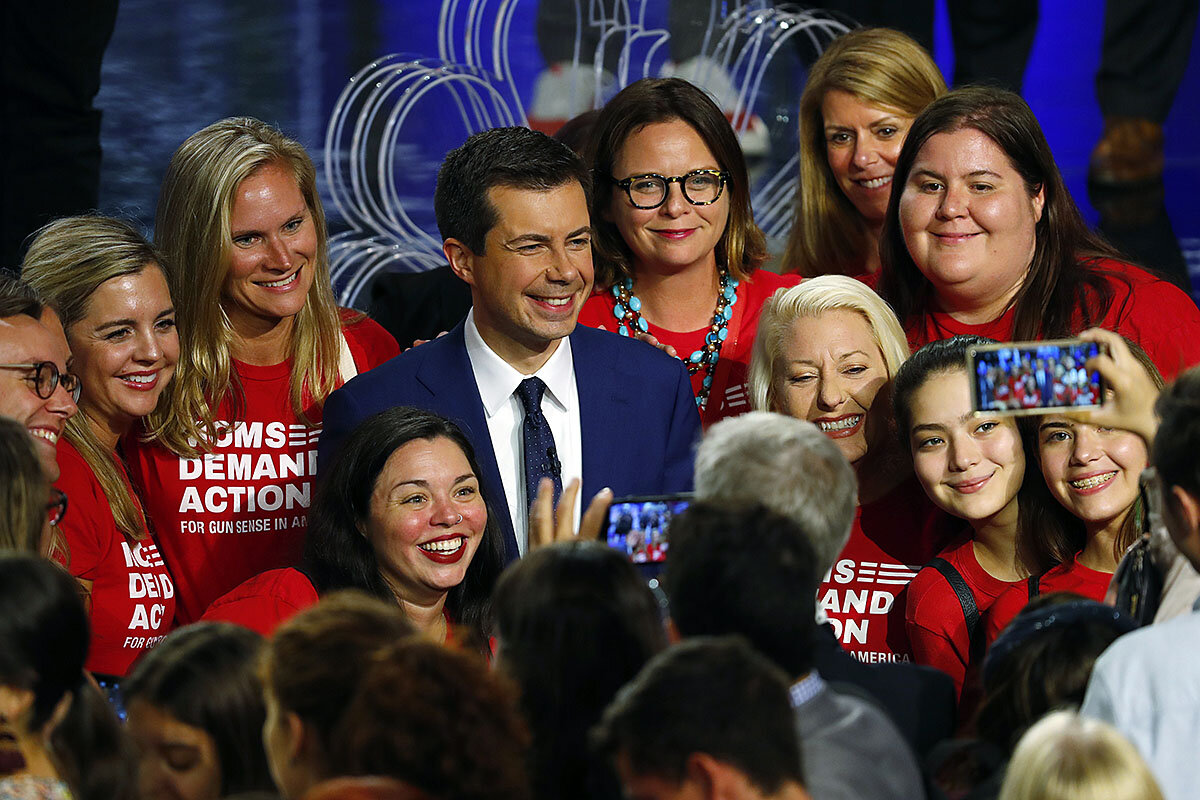Onstage, Democrats clash on ideas. Offstage, is there more common ground?
Loading...
| MIAMI
The candidates came into the spin room just before 11:30 p.m. through a barricaded walkway surrounded by press. One photographer, trying to get a good shot, tipped over a light. Another fell off the chair he was standing on.
There was some awkward shuffling as New York Mayor Bill de Blasio and his entourage squeezed past former Maryland Rep. John Delaney, who’d come in first and stopped to talk to reporters. Washington Gov. Jay Inslee held court off to the side of the ministage set up for the NBC commentators. Minnesota Sen. Amy Klobuchar later did the same, as campaign volunteers, bearing white signs printed with the candidates’ names, weaved in and out of the sea of people. When New Jersey Sen. Cory Booker walked in, mics and cameras swarmed around him – then dissolved and recongregated, like a school of fish, around Massachusetts Sen. Elizabeth Warren.
And that was just the first night.
Why We Wrote This
Yes, there are many – maybe too many – Democratic presidential candidates, as the first debates showed. But in their diversity they represent a party struggling to unify around new ideas and principles.
By the end of the second Democratic presidential debate on Thursday, it was clear that when 20 candidates descend on a city to make their case to the American people, a special kind of chaos comes to life. Offstage, the event drew an inordinate number of press and police, including some on horseback. There were protesters, campaign staff, volunteers, and flocks of engaged or simply curious citizens.
Onstage, the debates threw into sharp relief the deep divides cleaving today’s Democrats – and the very real challenge they face in the search for a unifying figure to lead them in 2020.
The question now isn’t whether the party has shifted left but just how much farther left it intends to go. On one side are the pragmatists, embodied by former Vice President Joe Biden. They see President Donald Trump as the single biggest threat to the nation’s well-being and are essentially pushing for a return to the vision and approach of the Obama years.
On the other are the idealists, like Senator Warren and Vermont Sen. Bernie Sanders, who argue that America’s problems are far bigger than the man in the White House and will require radical, systemic overhauls of government and the economy.
“When you’ve got an economy that does great for those with money and isn’t doing great for everyone else, that is corruption, pure and simple,” Senator Warren said, setting the tone on the first night. “We need to attack it head on.”
An even more uncomfortable fissure lies around the matter of identity. With young people and minorities making up a larger and larger share of the Democratic Party, many believe it’s crucial for the nominee to reflect the experiences of those demographics.
California Sen. Kamala Harris struck a sharp blow against Mr. Biden on the second night when she attacked his recent comments about having once worked with segregationists in the Senate. Speaking as the only African-American woman in the race, she told him: “It was hurtful.” She also criticized his opposition to busing during the 1970s. “You know, there was a little girl in California who was part of the second class to integrate her public schools, and she was bused to school every day.” she said. “And that little girl was me.”
California Rep. Eric Swalwell hit on the issue of generational change directly, urging Mr. Biden to “pass the torch.”
In the spin room afterward, rival campaigns downplayed the attacks on Mr. Biden – though most observers noted the strategy had had the intended effect. Which candidate or candidates stood to benefit most, however, was less clear.
“Clearly there were folks onstage who were saying that we’ve just got to sort of return to normal, that we can turn back the clock and go back to a pre-Donald Trump era,” said Lis Smith, the communications director for South Bend, Indiana, Mayor Pete Buttigieg – who is the youngest candidate in the race and the only one who is openly gay. But “normal isn’t working, and we’ve got to try something different.”
At Homestead
While party unity – and a consensus nominee – may be a long way off, a kind of camaraderie nevertheless emerged over the course of the two days as candidates and their staff were forced to interact and at times even work together.
During daytime hours, between rounds of debate prep, most of the Democrats at one point or another made pilgrimages to the Homestead Temporary Shelter for Unaccompanied Children, the site of a controversial for-profit migrant children’s detention center located 30 miles outside of Miami. Though none of the candidates were allowed into the center itself, all took the opportunity to denounce the Trump administration’s immigration policy – particularly the separation of families at the U.S.-Mexico border.
Senators Warren and Klobuchar both went on Wednesday. On Thursday, Senator Sanders and former Texas Rep. Beto O’Rourke each made visits. A video circulated on Twitter later of Mr. O’Rourke holding up a gigantic heart-shaped sign and yelling “We love you!” in Spanish to the children presumably on the other side of the chain-link fence surrounding the property.
On Friday morning, six candidates went there with Florida congresswoman Debbie Murcasel-Powell. They held a joint press conference there after also being turned away at the gates. Standing outside the chain-link fence, Senator Harris, New York Sen. Kirsten Gillibrand, Mr. Buttigieg, self-help author Marianne Williamson, former HUD Secretary Julian Castro, and former Colorado Gov. John Hickenlooper took turns addressing a small crowd of reporters and volunteers in the sweltering south Florida heat.
“I cannot tell you how angry it makes me,” Senator Gillibrand said, “when you lock up a child and deny them the time they need to play outside, the time they need to be with loved ones and family members.”
Activists welcomed the candidates’ presence as a chance to bring national attention to what’s been a longstanding community issue. Mariana Martinez, an organizer with American Friends Service Committee, said she hoped it would prove to be more than a photo op. “We need to see more,” she says. “We need to know these candidates are serious.”
It was somewhat remarkable to see a group of candidates who, less than 10 hours earlier, had been battling it out onstage now sharing a microphone and nodding together as each spoke in turn. And it was a reminder that, for all their differences, the Democrats still have more that unifies them than divides them.
Chatting briefly Thursday afternoon, former Maryland Rep. John Delaney underscored that point. “Some people want to dismantle the economic model of the United States, and I don’t have that goal,” he said. But on basic priorities like “universal health care, making school more affordable – I think we have those goals in common.”
The difference, he said, lies in how you get there. “Some people have practical, pragmatic ideas how to do it – and others don’t.”
“We need a competition of ideas,” Colorado Sen. Michael Bennet told reporters later. “It’ll be good for whoever the nominee is – I hope it’ll be me – to see this stuff clarified in this process.”
Overall vibe: Game 1
Outside the debate hall ahead of Round 2, professional arrow spinners swung giant cardboard signs that proclaimed “Delaney 2020” on one side and “#BetterCare,” referring to Mr. Delaney’s health-care reform plan, on the other. A trio of women in Marianne Williamson T-shirts laid a spread of her merchandise on a tarp on the sidewalk. There were pink Andrew Yang hats and yellow Harris signs and a pair of red, white, and blue beach chairs bearing Biden T-shirts.
Protesters, some in red Trump hats, gathered around a big banner that declared “No socialismo, no comunismo, somos capitalista” (“No socialism, no communism, we are capitalist”). An electronic signage truck, paid for by the New York Police Department’s union, which has a longstanding feud with Mayor de Blasio, circled the block flashing his face and accusing him of putting “working people last.”
For all the hoopla, the overall vibe was that of Game 1 in a long, competitive series. There will be no fewer than 12 debates, and as the candidates and their staffs are well aware, this round’s winners still have plenty of time to stumble – and the losers, potentially, to recover.
To that end, on Friday, Mr. Biden vigorously defended his “lifetime commitment” to civil rights during an appearance before the Rev. Jesse Jackson’s Rainbow PUSH Coalition in Chicago. “I will be a president who stands against racism,” he said. “We have a president who promotes hate and division,” he added. “Barack was a president our kids not only could but did look up to.”
Some political observers argue that the clashes over ideology and identity, while real, aren’t necessarily as central as they’re often made out to be. Most Democratic voters can’t be compartmentalized that easily. Many are simply looking for a candidate who speaks to them – someone who has conviction, who conveys compassion and authority.
“You can’t just divide this party into left and center; you can’t just divide it into progressive and moderate,” says Senator Booker’s campaign manager, Addisu Demissie, as a cluster of reporters and videographers bustle by. Voters, he says,” have to find somebody who shares their values – whom they believe and they can trust is motivated by the right things.”








